Cross-Cultural Teamwork: Strategies for Global Organizations Report
VerifiedAdded on 2020/04/15
|14
|3728
|250
Report
AI Summary
This report provides an executive summary, table of contents, and detailed analysis of cross-cultural teamwork within global organizations. It addresses the benefits of effective cross-cultural collaboration, emphasizing the impact of globalization and digitalization. The report identifies key challenges such as communication barriers (language, expression), cultural backgrounds, stereotyping, differing attitudes toward disclosure, religious differences, and negotiation etiquette. It offers recommendations for resolving cross-cultural issues, including learning about cultures, bridging cultural gaps, acknowledging differences, promoting effective communication, and implementing disciplinary actions. The report concludes by summarizing the importance of understanding and managing cultural diversity for improving organizational performance and fostering sustainable development in international business settings.
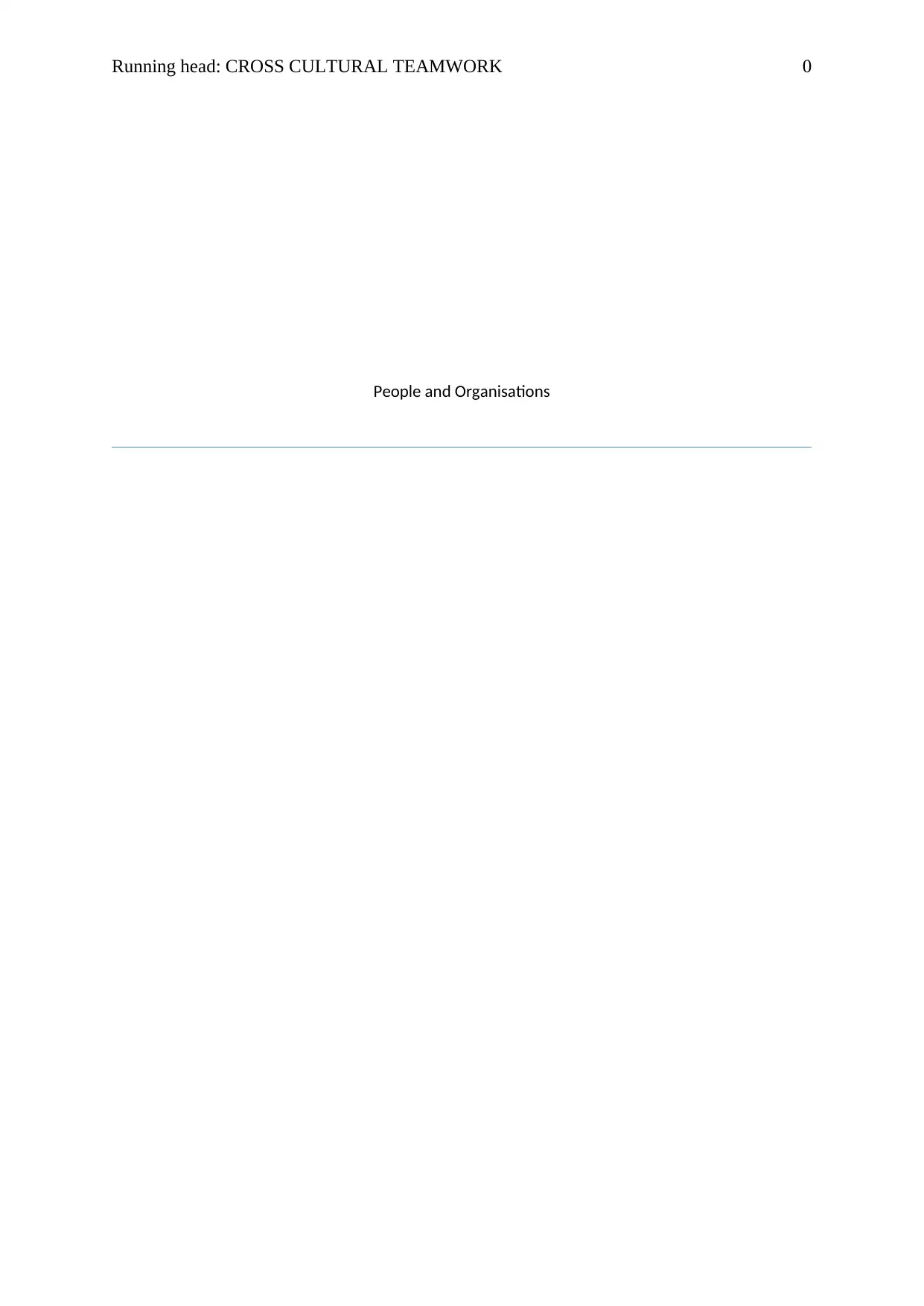
Running head: CROSS CULTURAL TEAMWORK 0
People and Organisations
People and Organisations
Paraphrase This Document
Need a fresh take? Get an instant paraphrase of this document with our AI Paraphraser
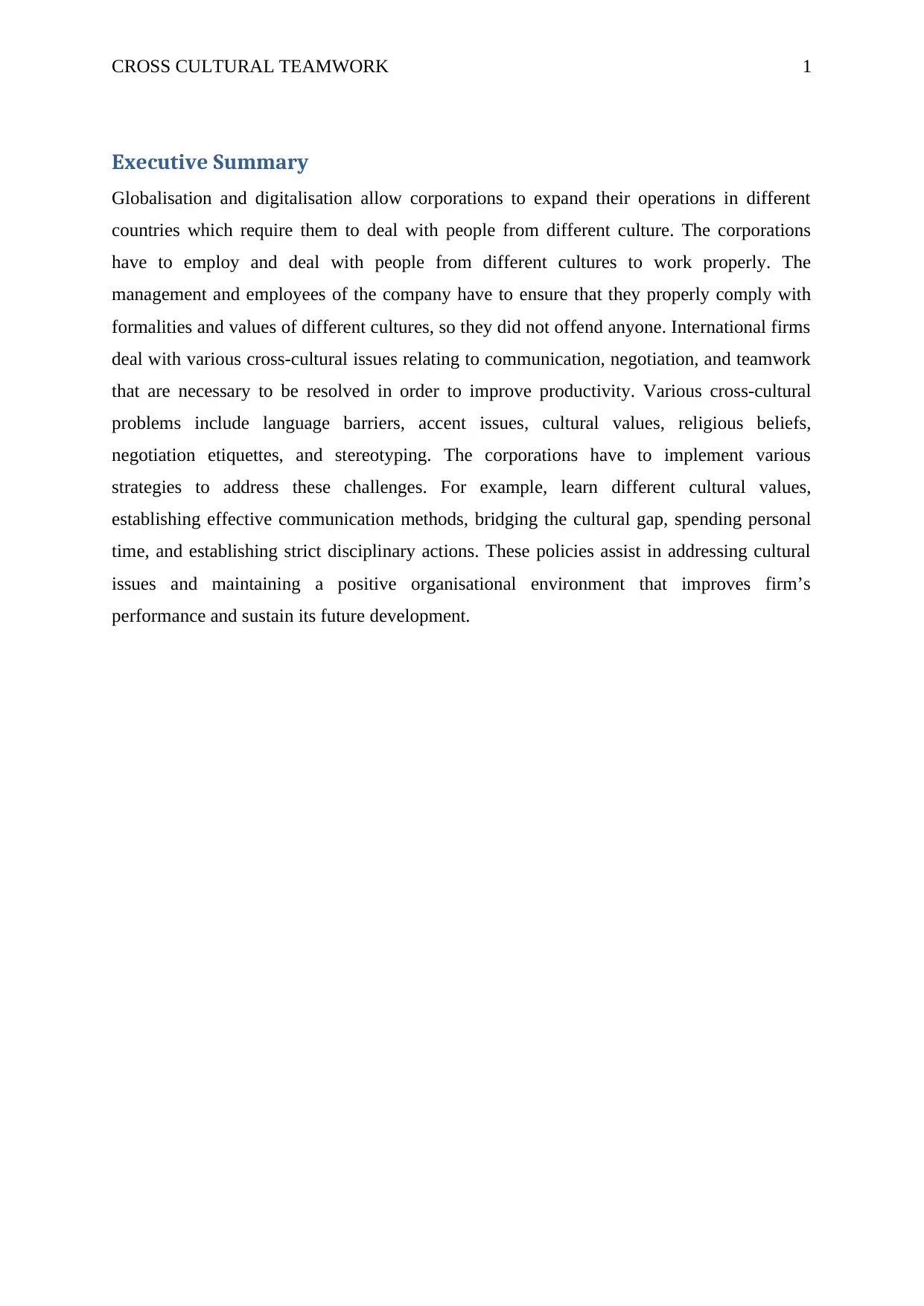
CROSS CULTURAL TEAMWORK 1
Executive Summary
Globalisation and digitalisation allow corporations to expand their operations in different
countries which require them to deal with people from different culture. The corporations
have to employ and deal with people from different cultures to work properly. The
management and employees of the company have to ensure that they properly comply with
formalities and values of different cultures, so they did not offend anyone. International firms
deal with various cross-cultural issues relating to communication, negotiation, and teamwork
that are necessary to be resolved in order to improve productivity. Various cross-cultural
problems include language barriers, accent issues, cultural values, religious beliefs,
negotiation etiquettes, and stereotyping. The corporations have to implement various
strategies to address these challenges. For example, learn different cultural values,
establishing effective communication methods, bridging the cultural gap, spending personal
time, and establishing strict disciplinary actions. These policies assist in addressing cultural
issues and maintaining a positive organisational environment that improves firm’s
performance and sustain its future development.
Executive Summary
Globalisation and digitalisation allow corporations to expand their operations in different
countries which require them to deal with people from different culture. The corporations
have to employ and deal with people from different cultures to work properly. The
management and employees of the company have to ensure that they properly comply with
formalities and values of different cultures, so they did not offend anyone. International firms
deal with various cross-cultural issues relating to communication, negotiation, and teamwork
that are necessary to be resolved in order to improve productivity. Various cross-cultural
problems include language barriers, accent issues, cultural values, religious beliefs,
negotiation etiquettes, and stereotyping. The corporations have to implement various
strategies to address these challenges. For example, learn different cultural values,
establishing effective communication methods, bridging the cultural gap, spending personal
time, and establishing strict disciplinary actions. These policies assist in addressing cultural
issues and maintaining a positive organisational environment that improves firm’s
performance and sustain its future development.
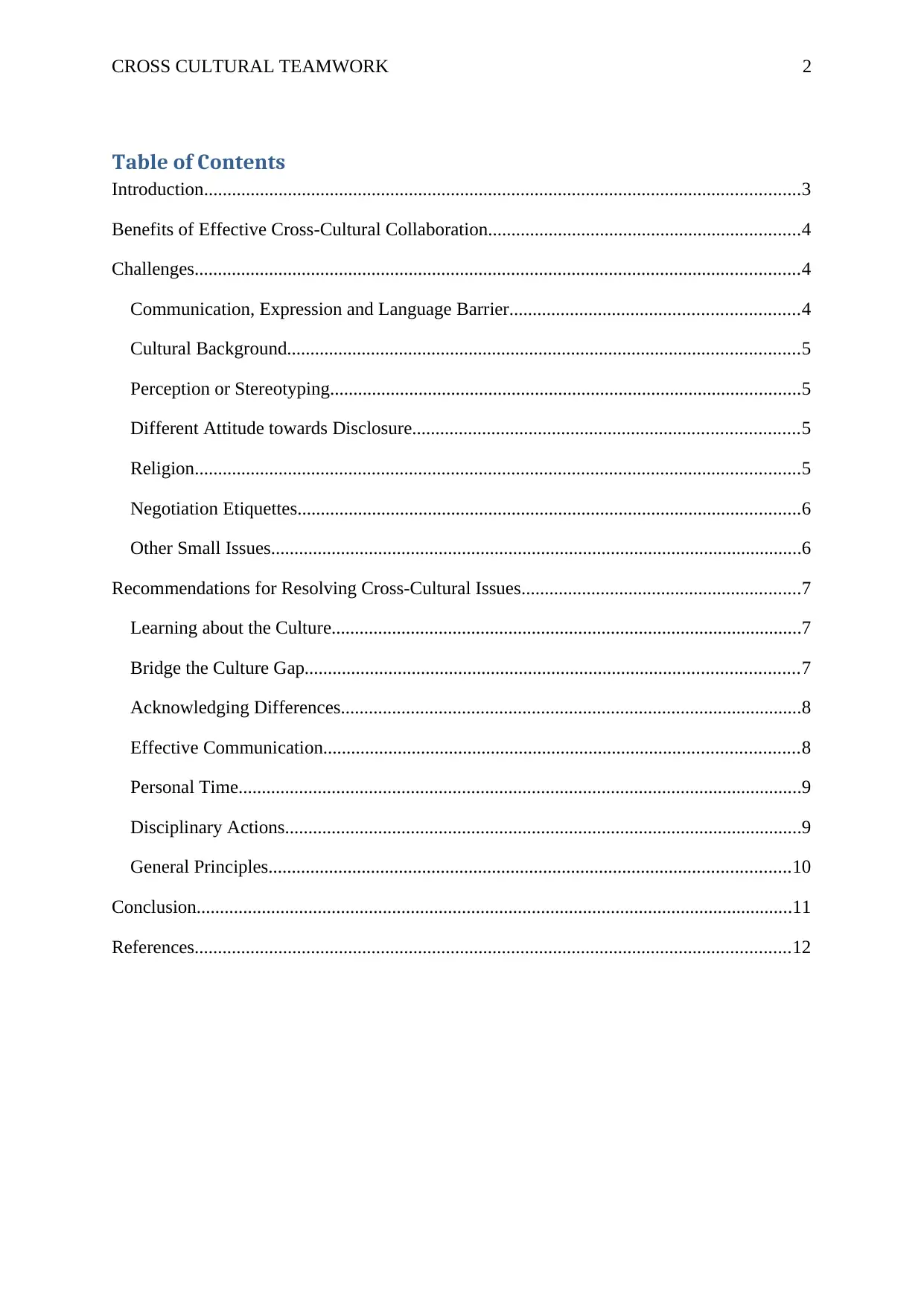
CROSS CULTURAL TEAMWORK 2
Table of Contents
Introduction................................................................................................................................3
Benefits of Effective Cross-Cultural Collaboration...................................................................4
Challenges..................................................................................................................................4
Communication, Expression and Language Barrier..............................................................4
Cultural Background..............................................................................................................5
Perception or Stereotyping.....................................................................................................5
Different Attitude towards Disclosure...................................................................................5
Religion..................................................................................................................................5
Negotiation Etiquettes............................................................................................................6
Other Small Issues..................................................................................................................6
Recommendations for Resolving Cross-Cultural Issues............................................................7
Learning about the Culture.....................................................................................................7
Bridge the Culture Gap..........................................................................................................7
Acknowledging Differences...................................................................................................8
Effective Communication......................................................................................................8
Personal Time.........................................................................................................................9
Disciplinary Actions...............................................................................................................9
General Principles................................................................................................................10
Conclusion................................................................................................................................11
References................................................................................................................................12
Table of Contents
Introduction................................................................................................................................3
Benefits of Effective Cross-Cultural Collaboration...................................................................4
Challenges..................................................................................................................................4
Communication, Expression and Language Barrier..............................................................4
Cultural Background..............................................................................................................5
Perception or Stereotyping.....................................................................................................5
Different Attitude towards Disclosure...................................................................................5
Religion..................................................................................................................................5
Negotiation Etiquettes............................................................................................................6
Other Small Issues..................................................................................................................6
Recommendations for Resolving Cross-Cultural Issues............................................................7
Learning about the Culture.....................................................................................................7
Bridge the Culture Gap..........................................................................................................7
Acknowledging Differences...................................................................................................8
Effective Communication......................................................................................................8
Personal Time.........................................................................................................................9
Disciplinary Actions...............................................................................................................9
General Principles................................................................................................................10
Conclusion................................................................................................................................11
References................................................................................................................................12
⊘ This is a preview!⊘
Do you want full access?
Subscribe today to unlock all pages.

Trusted by 1+ million students worldwide
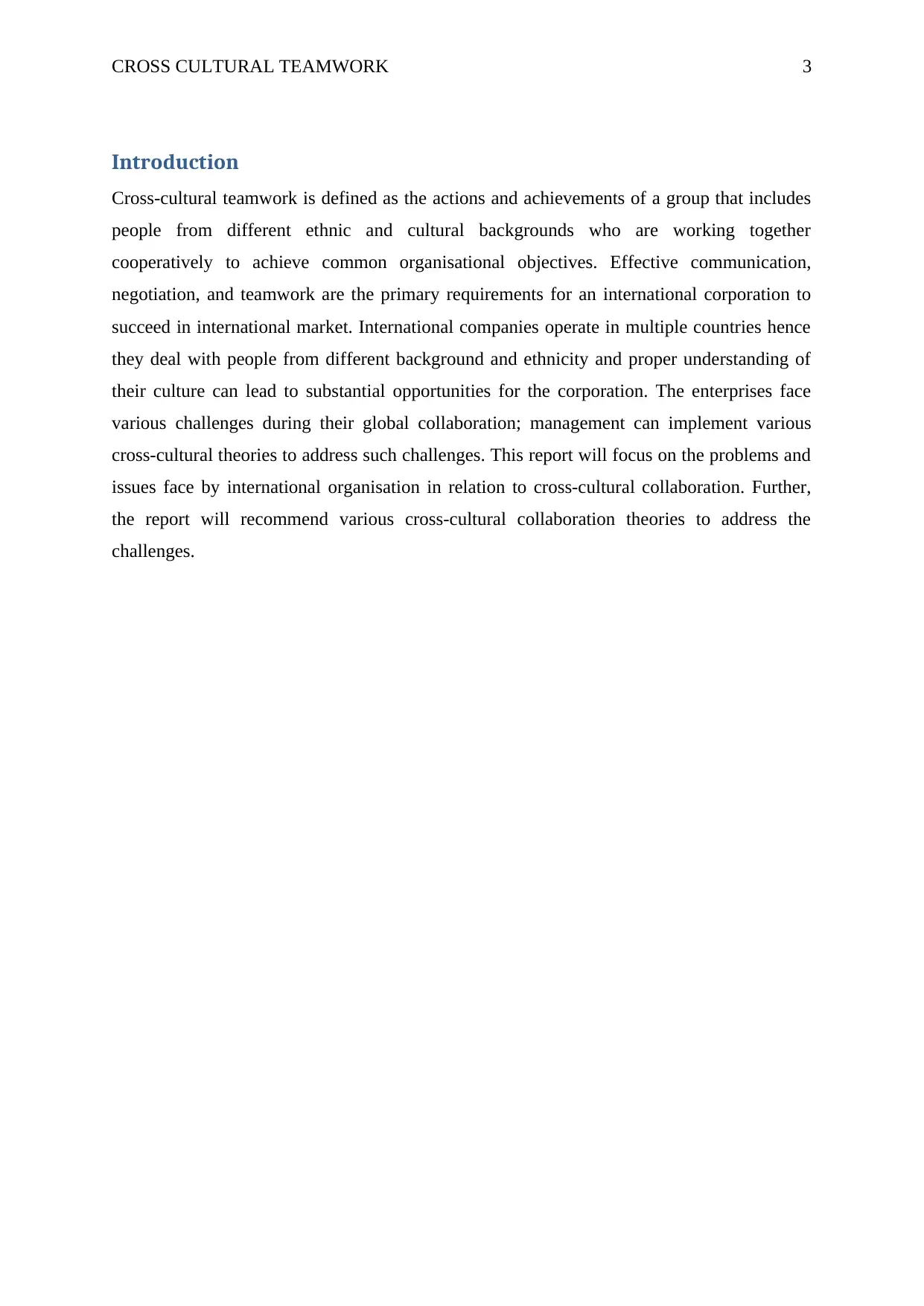
CROSS CULTURAL TEAMWORK 3
Introduction
Cross-cultural teamwork is defined as the actions and achievements of a group that includes
people from different ethnic and cultural backgrounds who are working together
cooperatively to achieve common organisational objectives. Effective communication,
negotiation, and teamwork are the primary requirements for an international corporation to
succeed in international market. International companies operate in multiple countries hence
they deal with people from different background and ethnicity and proper understanding of
their culture can lead to substantial opportunities for the corporation. The enterprises face
various challenges during their global collaboration; management can implement various
cross-cultural theories to address such challenges. This report will focus on the problems and
issues face by international organisation in relation to cross-cultural collaboration. Further,
the report will recommend various cross-cultural collaboration theories to address the
challenges.
Introduction
Cross-cultural teamwork is defined as the actions and achievements of a group that includes
people from different ethnic and cultural backgrounds who are working together
cooperatively to achieve common organisational objectives. Effective communication,
negotiation, and teamwork are the primary requirements for an international corporation to
succeed in international market. International companies operate in multiple countries hence
they deal with people from different background and ethnicity and proper understanding of
their culture can lead to substantial opportunities for the corporation. The enterprises face
various challenges during their global collaboration; management can implement various
cross-cultural theories to address such challenges. This report will focus on the problems and
issues face by international organisation in relation to cross-cultural collaboration. Further,
the report will recommend various cross-cultural collaboration theories to address the
challenges.
Paraphrase This Document
Need a fresh take? Get an instant paraphrase of this document with our AI Paraphraser
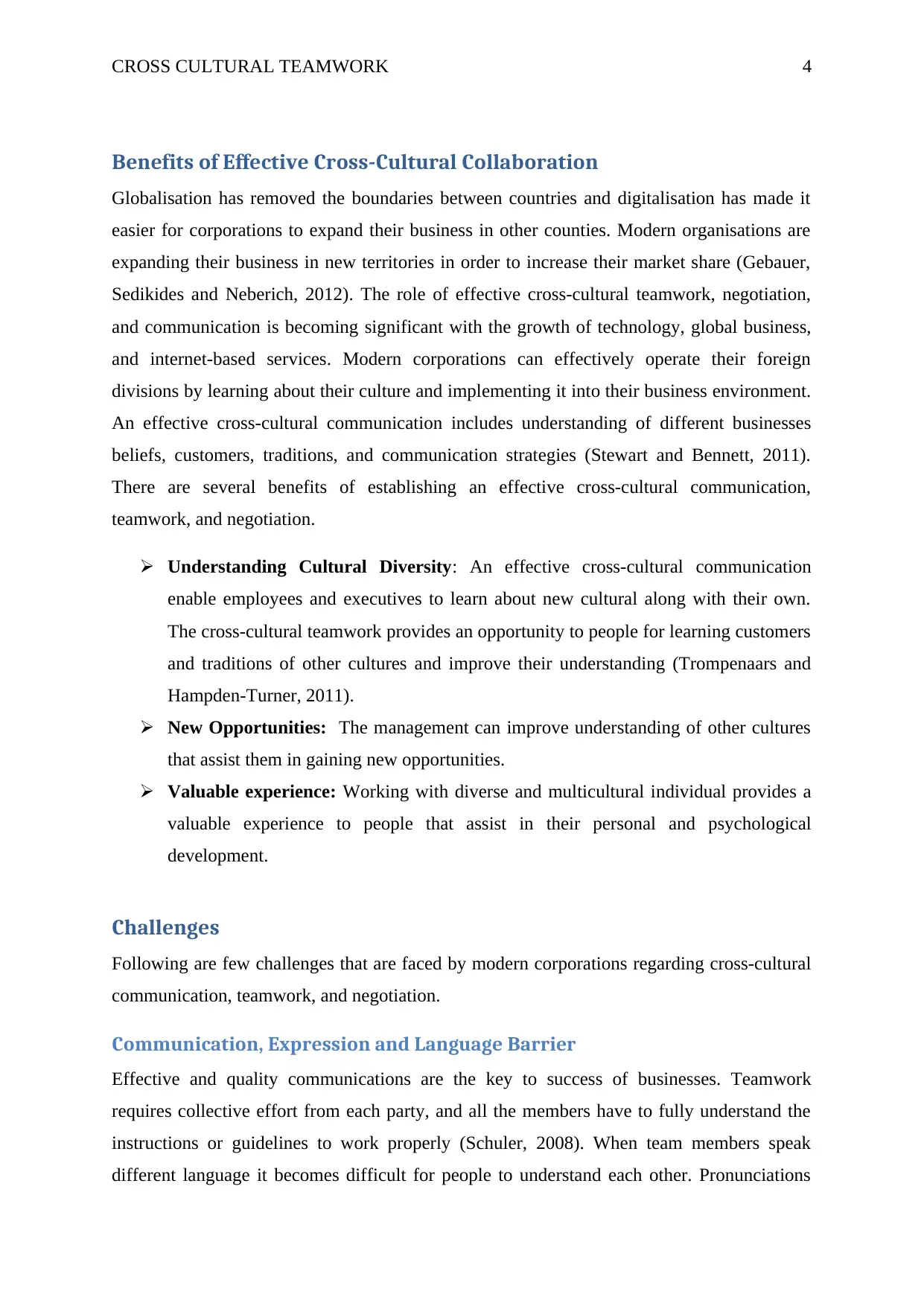
CROSS CULTURAL TEAMWORK 4
Benefits of Effective Cross-Cultural Collaboration
Globalisation has removed the boundaries between countries and digitalisation has made it
easier for corporations to expand their business in other counties. Modern organisations are
expanding their business in new territories in order to increase their market share (Gebauer,
Sedikides and Neberich, 2012). The role of effective cross-cultural teamwork, negotiation,
and communication is becoming significant with the growth of technology, global business,
and internet-based services. Modern corporations can effectively operate their foreign
divisions by learning about their culture and implementing it into their business environment.
An effective cross-cultural communication includes understanding of different businesses
beliefs, customers, traditions, and communication strategies (Stewart and Bennett, 2011).
There are several benefits of establishing an effective cross-cultural communication,
teamwork, and negotiation.
Understanding Cultural Diversity: An effective cross-cultural communication
enable employees and executives to learn about new cultural along with their own.
The cross-cultural teamwork provides an opportunity to people for learning customers
and traditions of other cultures and improve their understanding (Trompenaars and
Hampden-Turner, 2011).
New Opportunities: The management can improve understanding of other cultures
that assist them in gaining new opportunities.
Valuable experience: Working with diverse and multicultural individual provides a
valuable experience to people that assist in their personal and psychological
development.
Challenges
Following are few challenges that are faced by modern corporations regarding cross-cultural
communication, teamwork, and negotiation.
Communication, Expression and Language Barrier
Effective and quality communications are the key to success of businesses. Teamwork
requires collective effort from each party, and all the members have to fully understand the
instructions or guidelines to work properly (Schuler, 2008). When team members speak
different language it becomes difficult for people to understand each other. Pronunciations
Benefits of Effective Cross-Cultural Collaboration
Globalisation has removed the boundaries between countries and digitalisation has made it
easier for corporations to expand their business in other counties. Modern organisations are
expanding their business in new territories in order to increase their market share (Gebauer,
Sedikides and Neberich, 2012). The role of effective cross-cultural teamwork, negotiation,
and communication is becoming significant with the growth of technology, global business,
and internet-based services. Modern corporations can effectively operate their foreign
divisions by learning about their culture and implementing it into their business environment.
An effective cross-cultural communication includes understanding of different businesses
beliefs, customers, traditions, and communication strategies (Stewart and Bennett, 2011).
There are several benefits of establishing an effective cross-cultural communication,
teamwork, and negotiation.
Understanding Cultural Diversity: An effective cross-cultural communication
enable employees and executives to learn about new cultural along with their own.
The cross-cultural teamwork provides an opportunity to people for learning customers
and traditions of other cultures and improve their understanding (Trompenaars and
Hampden-Turner, 2011).
New Opportunities: The management can improve understanding of other cultures
that assist them in gaining new opportunities.
Valuable experience: Working with diverse and multicultural individual provides a
valuable experience to people that assist in their personal and psychological
development.
Challenges
Following are few challenges that are faced by modern corporations regarding cross-cultural
communication, teamwork, and negotiation.
Communication, Expression and Language Barrier
Effective and quality communications are the key to success of businesses. Teamwork
requires collective effort from each party, and all the members have to fully understand the
instructions or guidelines to work properly (Schuler, 2008). When team members speak
different language it becomes difficult for people to understand each other. Pronunciations
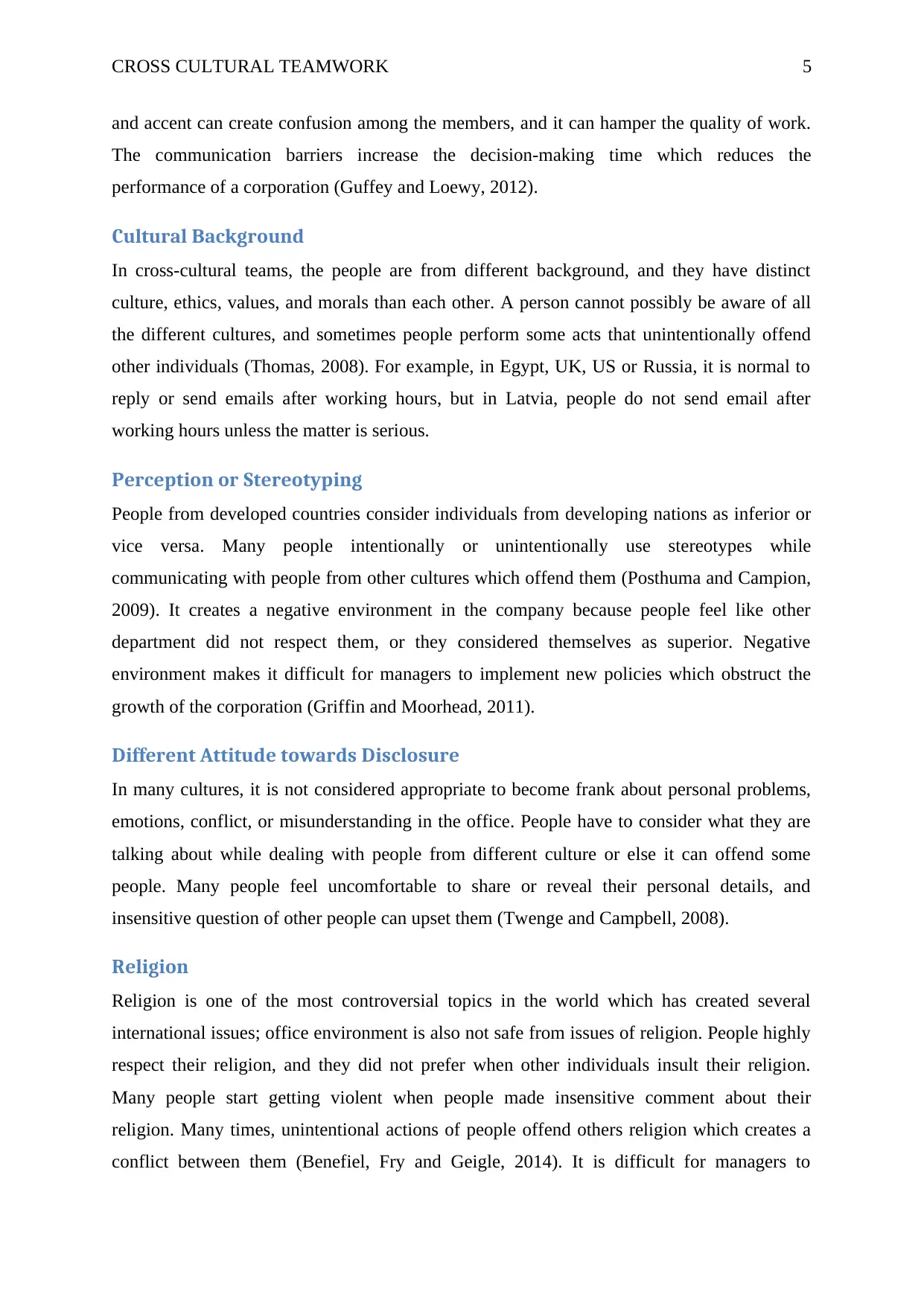
CROSS CULTURAL TEAMWORK 5
and accent can create confusion among the members, and it can hamper the quality of work.
The communication barriers increase the decision-making time which reduces the
performance of a corporation (Guffey and Loewy, 2012).
Cultural Background
In cross-cultural teams, the people are from different background, and they have distinct
culture, ethics, values, and morals than each other. A person cannot possibly be aware of all
the different cultures, and sometimes people perform some acts that unintentionally offend
other individuals (Thomas, 2008). For example, in Egypt, UK, US or Russia, it is normal to
reply or send emails after working hours, but in Latvia, people do not send email after
working hours unless the matter is serious.
Perception or Stereotyping
People from developed countries consider individuals from developing nations as inferior or
vice versa. Many people intentionally or unintentionally use stereotypes while
communicating with people from other cultures which offend them (Posthuma and Campion,
2009). It creates a negative environment in the company because people feel like other
department did not respect them, or they considered themselves as superior. Negative
environment makes it difficult for managers to implement new policies which obstruct the
growth of the corporation (Griffin and Moorhead, 2011).
Different Attitude towards Disclosure
In many cultures, it is not considered appropriate to become frank about personal problems,
emotions, conflict, or misunderstanding in the office. People have to consider what they are
talking about while dealing with people from different culture or else it can offend some
people. Many people feel uncomfortable to share or reveal their personal details, and
insensitive question of other people can upset them (Twenge and Campbell, 2008).
Religion
Religion is one of the most controversial topics in the world which has created several
international issues; office environment is also not safe from issues of religion. People highly
respect their religion, and they did not prefer when other individuals insult their religion.
Many people start getting violent when people made insensitive comment about their
religion. Many times, unintentional actions of people offend others religion which creates a
conflict between them (Benefiel, Fry and Geigle, 2014). It is difficult for managers to
and accent can create confusion among the members, and it can hamper the quality of work.
The communication barriers increase the decision-making time which reduces the
performance of a corporation (Guffey and Loewy, 2012).
Cultural Background
In cross-cultural teams, the people are from different background, and they have distinct
culture, ethics, values, and morals than each other. A person cannot possibly be aware of all
the different cultures, and sometimes people perform some acts that unintentionally offend
other individuals (Thomas, 2008). For example, in Egypt, UK, US or Russia, it is normal to
reply or send emails after working hours, but in Latvia, people do not send email after
working hours unless the matter is serious.
Perception or Stereotyping
People from developed countries consider individuals from developing nations as inferior or
vice versa. Many people intentionally or unintentionally use stereotypes while
communicating with people from other cultures which offend them (Posthuma and Campion,
2009). It creates a negative environment in the company because people feel like other
department did not respect them, or they considered themselves as superior. Negative
environment makes it difficult for managers to implement new policies which obstruct the
growth of the corporation (Griffin and Moorhead, 2011).
Different Attitude towards Disclosure
In many cultures, it is not considered appropriate to become frank about personal problems,
emotions, conflict, or misunderstanding in the office. People have to consider what they are
talking about while dealing with people from different culture or else it can offend some
people. Many people feel uncomfortable to share or reveal their personal details, and
insensitive question of other people can upset them (Twenge and Campbell, 2008).
Religion
Religion is one of the most controversial topics in the world which has created several
international issues; office environment is also not safe from issues of religion. People highly
respect their religion, and they did not prefer when other individuals insult their religion.
Many people start getting violent when people made insensitive comment about their
religion. Many times, unintentional actions of people offend others religion which creates a
conflict between them (Benefiel, Fry and Geigle, 2014). It is difficult for managers to
⊘ This is a preview!⊘
Do you want full access?
Subscribe today to unlock all pages.

Trusted by 1+ million students worldwide
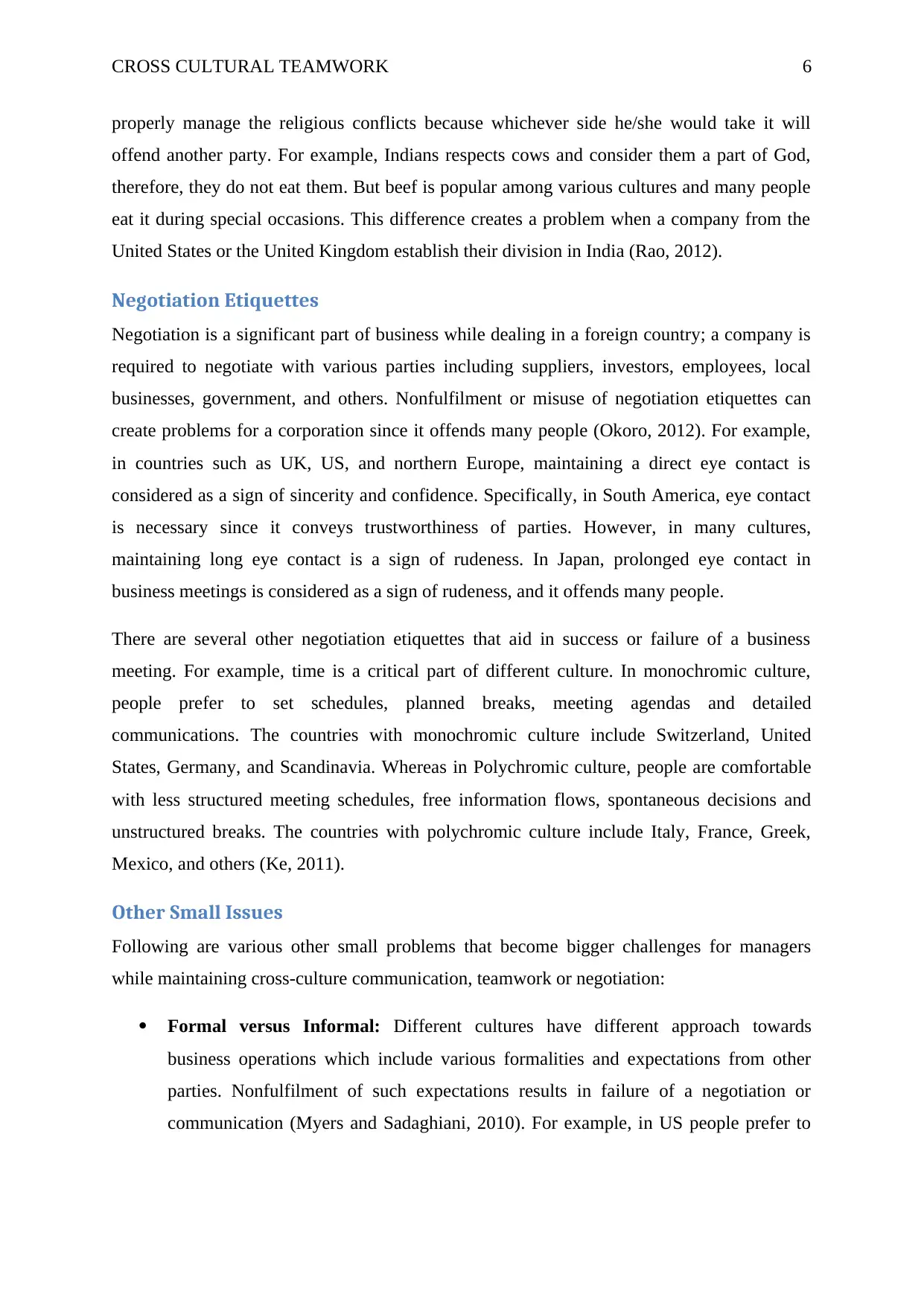
CROSS CULTURAL TEAMWORK 6
properly manage the religious conflicts because whichever side he/she would take it will
offend another party. For example, Indians respects cows and consider them a part of God,
therefore, they do not eat them. But beef is popular among various cultures and many people
eat it during special occasions. This difference creates a problem when a company from the
United States or the United Kingdom establish their division in India (Rao, 2012).
Negotiation Etiquettes
Negotiation is a significant part of business while dealing in a foreign country; a company is
required to negotiate with various parties including suppliers, investors, employees, local
businesses, government, and others. Nonfulfilment or misuse of negotiation etiquettes can
create problems for a corporation since it offends many people (Okoro, 2012). For example,
in countries such as UK, US, and northern Europe, maintaining a direct eye contact is
considered as a sign of sincerity and confidence. Specifically, in South America, eye contact
is necessary since it conveys trustworthiness of parties. However, in many cultures,
maintaining long eye contact is a sign of rudeness. In Japan, prolonged eye contact in
business meetings is considered as a sign of rudeness, and it offends many people.
There are several other negotiation etiquettes that aid in success or failure of a business
meeting. For example, time is a critical part of different culture. In monochromic culture,
people prefer to set schedules, planned breaks, meeting agendas and detailed
communications. The countries with monochromic culture include Switzerland, United
States, Germany, and Scandinavia. Whereas in Polychromic culture, people are comfortable
with less structured meeting schedules, free information flows, spontaneous decisions and
unstructured breaks. The countries with polychromic culture include Italy, France, Greek,
Mexico, and others (Ke, 2011).
Other Small Issues
Following are various other small problems that become bigger challenges for managers
while maintaining cross-culture communication, teamwork or negotiation:
Formal versus Informal: Different cultures have different approach towards
business operations which include various formalities and expectations from other
parties. Nonfulfilment of such expectations results in failure of a negotiation or
communication (Myers and Sadaghiani, 2010). For example, in US people prefer to
properly manage the religious conflicts because whichever side he/she would take it will
offend another party. For example, Indians respects cows and consider them a part of God,
therefore, they do not eat them. But beef is popular among various cultures and many people
eat it during special occasions. This difference creates a problem when a company from the
United States or the United Kingdom establish their division in India (Rao, 2012).
Negotiation Etiquettes
Negotiation is a significant part of business while dealing in a foreign country; a company is
required to negotiate with various parties including suppliers, investors, employees, local
businesses, government, and others. Nonfulfilment or misuse of negotiation etiquettes can
create problems for a corporation since it offends many people (Okoro, 2012). For example,
in countries such as UK, US, and northern Europe, maintaining a direct eye contact is
considered as a sign of sincerity and confidence. Specifically, in South America, eye contact
is necessary since it conveys trustworthiness of parties. However, in many cultures,
maintaining long eye contact is a sign of rudeness. In Japan, prolonged eye contact in
business meetings is considered as a sign of rudeness, and it offends many people.
There are several other negotiation etiquettes that aid in success or failure of a business
meeting. For example, time is a critical part of different culture. In monochromic culture,
people prefer to set schedules, planned breaks, meeting agendas and detailed
communications. The countries with monochromic culture include Switzerland, United
States, Germany, and Scandinavia. Whereas in Polychromic culture, people are comfortable
with less structured meeting schedules, free information flows, spontaneous decisions and
unstructured breaks. The countries with polychromic culture include Italy, France, Greek,
Mexico, and others (Ke, 2011).
Other Small Issues
Following are various other small problems that become bigger challenges for managers
while maintaining cross-culture communication, teamwork or negotiation:
Formal versus Informal: Different cultures have different approach towards
business operations which include various formalities and expectations from other
parties. Nonfulfilment of such expectations results in failure of a negotiation or
communication (Myers and Sadaghiani, 2010). For example, in US people prefer to
Paraphrase This Document
Need a fresh take? Get an instant paraphrase of this document with our AI Paraphraser
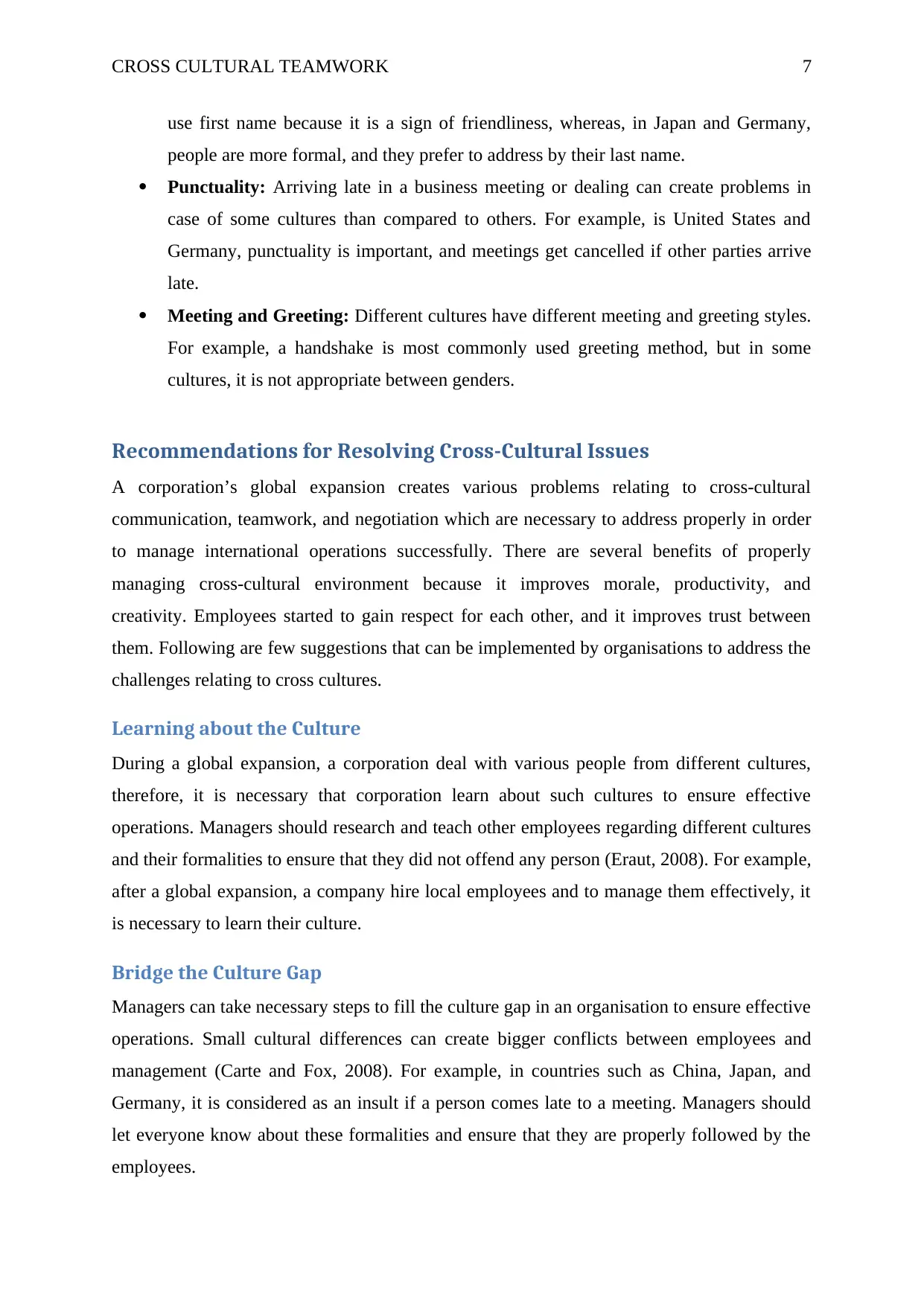
CROSS CULTURAL TEAMWORK 7
use first name because it is a sign of friendliness, whereas, in Japan and Germany,
people are more formal, and they prefer to address by their last name.
Punctuality: Arriving late in a business meeting or dealing can create problems in
case of some cultures than compared to others. For example, is United States and
Germany, punctuality is important, and meetings get cancelled if other parties arrive
late.
Meeting and Greeting: Different cultures have different meeting and greeting styles.
For example, a handshake is most commonly used greeting method, but in some
cultures, it is not appropriate between genders.
Recommendations for Resolving Cross-Cultural Issues
A corporation’s global expansion creates various problems relating to cross-cultural
communication, teamwork, and negotiation which are necessary to address properly in order
to manage international operations successfully. There are several benefits of properly
managing cross-cultural environment because it improves morale, productivity, and
creativity. Employees started to gain respect for each other, and it improves trust between
them. Following are few suggestions that can be implemented by organisations to address the
challenges relating to cross cultures.
Learning about the Culture
During a global expansion, a corporation deal with various people from different cultures,
therefore, it is necessary that corporation learn about such cultures to ensure effective
operations. Managers should research and teach other employees regarding different cultures
and their formalities to ensure that they did not offend any person (Eraut, 2008). For example,
after a global expansion, a company hire local employees and to manage them effectively, it
is necessary to learn their culture.
Bridge the Culture Gap
Managers can take necessary steps to fill the culture gap in an organisation to ensure effective
operations. Small cultural differences can create bigger conflicts between employees and
management (Carte and Fox, 2008). For example, in countries such as China, Japan, and
Germany, it is considered as an insult if a person comes late to a meeting. Managers should
let everyone know about these formalities and ensure that they are properly followed by the
employees.
use first name because it is a sign of friendliness, whereas, in Japan and Germany,
people are more formal, and they prefer to address by their last name.
Punctuality: Arriving late in a business meeting or dealing can create problems in
case of some cultures than compared to others. For example, is United States and
Germany, punctuality is important, and meetings get cancelled if other parties arrive
late.
Meeting and Greeting: Different cultures have different meeting and greeting styles.
For example, a handshake is most commonly used greeting method, but in some
cultures, it is not appropriate between genders.
Recommendations for Resolving Cross-Cultural Issues
A corporation’s global expansion creates various problems relating to cross-cultural
communication, teamwork, and negotiation which are necessary to address properly in order
to manage international operations successfully. There are several benefits of properly
managing cross-cultural environment because it improves morale, productivity, and
creativity. Employees started to gain respect for each other, and it improves trust between
them. Following are few suggestions that can be implemented by organisations to address the
challenges relating to cross cultures.
Learning about the Culture
During a global expansion, a corporation deal with various people from different cultures,
therefore, it is necessary that corporation learn about such cultures to ensure effective
operations. Managers should research and teach other employees regarding different cultures
and their formalities to ensure that they did not offend any person (Eraut, 2008). For example,
after a global expansion, a company hire local employees and to manage them effectively, it
is necessary to learn their culture.
Bridge the Culture Gap
Managers can take necessary steps to fill the culture gap in an organisation to ensure effective
operations. Small cultural differences can create bigger conflicts between employees and
management (Carte and Fox, 2008). For example, in countries such as China, Japan, and
Germany, it is considered as an insult if a person comes late to a meeting. Managers should
let everyone know about these formalities and ensure that they are properly followed by the
employees.
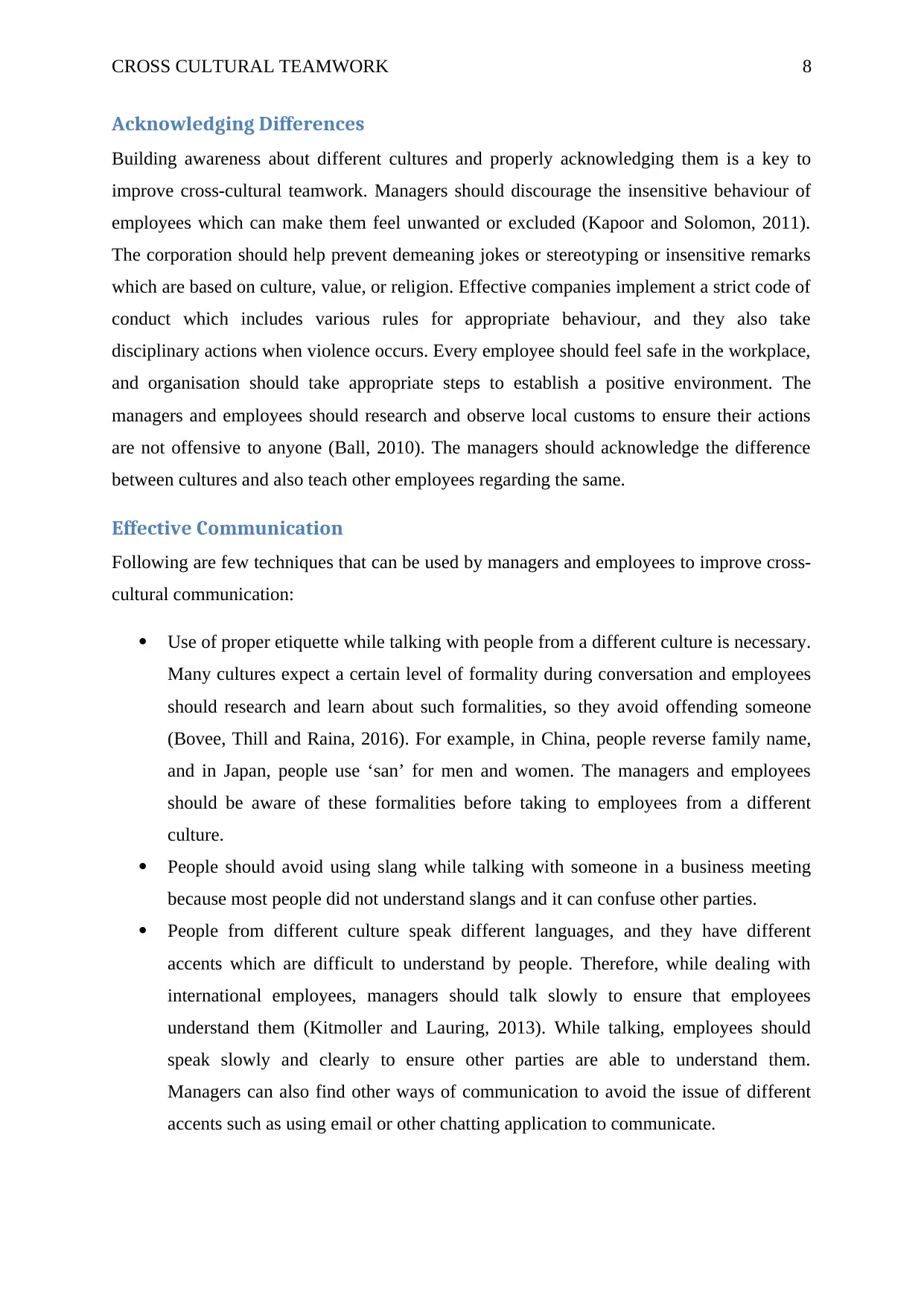
CROSS CULTURAL TEAMWORK 8
Acknowledging Differences
Building awareness about different cultures and properly acknowledging them is a key to
improve cross-cultural teamwork. Managers should discourage the insensitive behaviour of
employees which can make them feel unwanted or excluded (Kapoor and Solomon, 2011).
The corporation should help prevent demeaning jokes or stereotyping or insensitive remarks
which are based on culture, value, or religion. Effective companies implement a strict code of
conduct which includes various rules for appropriate behaviour, and they also take
disciplinary actions when violence occurs. Every employee should feel safe in the workplace,
and organisation should take appropriate steps to establish a positive environment. The
managers and employees should research and observe local customs to ensure their actions
are not offensive to anyone (Ball, 2010). The managers should acknowledge the difference
between cultures and also teach other employees regarding the same.
Effective Communication
Following are few techniques that can be used by managers and employees to improve cross-
cultural communication:
Use of proper etiquette while talking with people from a different culture is necessary.
Many cultures expect a certain level of formality during conversation and employees
should research and learn about such formalities, so they avoid offending someone
(Bovee, Thill and Raina, 2016). For example, in China, people reverse family name,
and in Japan, people use ‘san’ for men and women. The managers and employees
should be aware of these formalities before taking to employees from a different
culture.
People should avoid using slang while talking with someone in a business meeting
because most people did not understand slangs and it can confuse other parties.
People from different culture speak different languages, and they have different
accents which are difficult to understand by people. Therefore, while dealing with
international employees, managers should talk slowly to ensure that employees
understand them (Kitmoller and Lauring, 2013). While talking, employees should
speak slowly and clearly to ensure other parties are able to understand them.
Managers can also find other ways of communication to avoid the issue of different
accents such as using email or other chatting application to communicate.
Acknowledging Differences
Building awareness about different cultures and properly acknowledging them is a key to
improve cross-cultural teamwork. Managers should discourage the insensitive behaviour of
employees which can make them feel unwanted or excluded (Kapoor and Solomon, 2011).
The corporation should help prevent demeaning jokes or stereotyping or insensitive remarks
which are based on culture, value, or religion. Effective companies implement a strict code of
conduct which includes various rules for appropriate behaviour, and they also take
disciplinary actions when violence occurs. Every employee should feel safe in the workplace,
and organisation should take appropriate steps to establish a positive environment. The
managers and employees should research and observe local customs to ensure their actions
are not offensive to anyone (Ball, 2010). The managers should acknowledge the difference
between cultures and also teach other employees regarding the same.
Effective Communication
Following are few techniques that can be used by managers and employees to improve cross-
cultural communication:
Use of proper etiquette while talking with people from a different culture is necessary.
Many cultures expect a certain level of formality during conversation and employees
should research and learn about such formalities, so they avoid offending someone
(Bovee, Thill and Raina, 2016). For example, in China, people reverse family name,
and in Japan, people use ‘san’ for men and women. The managers and employees
should be aware of these formalities before taking to employees from a different
culture.
People should avoid using slang while talking with someone in a business meeting
because most people did not understand slangs and it can confuse other parties.
People from different culture speak different languages, and they have different
accents which are difficult to understand by people. Therefore, while dealing with
international employees, managers should talk slowly to ensure that employees
understand them (Kitmoller and Lauring, 2013). While talking, employees should
speak slowly and clearly to ensure other parties are able to understand them.
Managers can also find other ways of communication to avoid the issue of different
accents such as using email or other chatting application to communicate.
⊘ This is a preview!⊘
Do you want full access?
Subscribe today to unlock all pages.

Trusted by 1+ million students worldwide
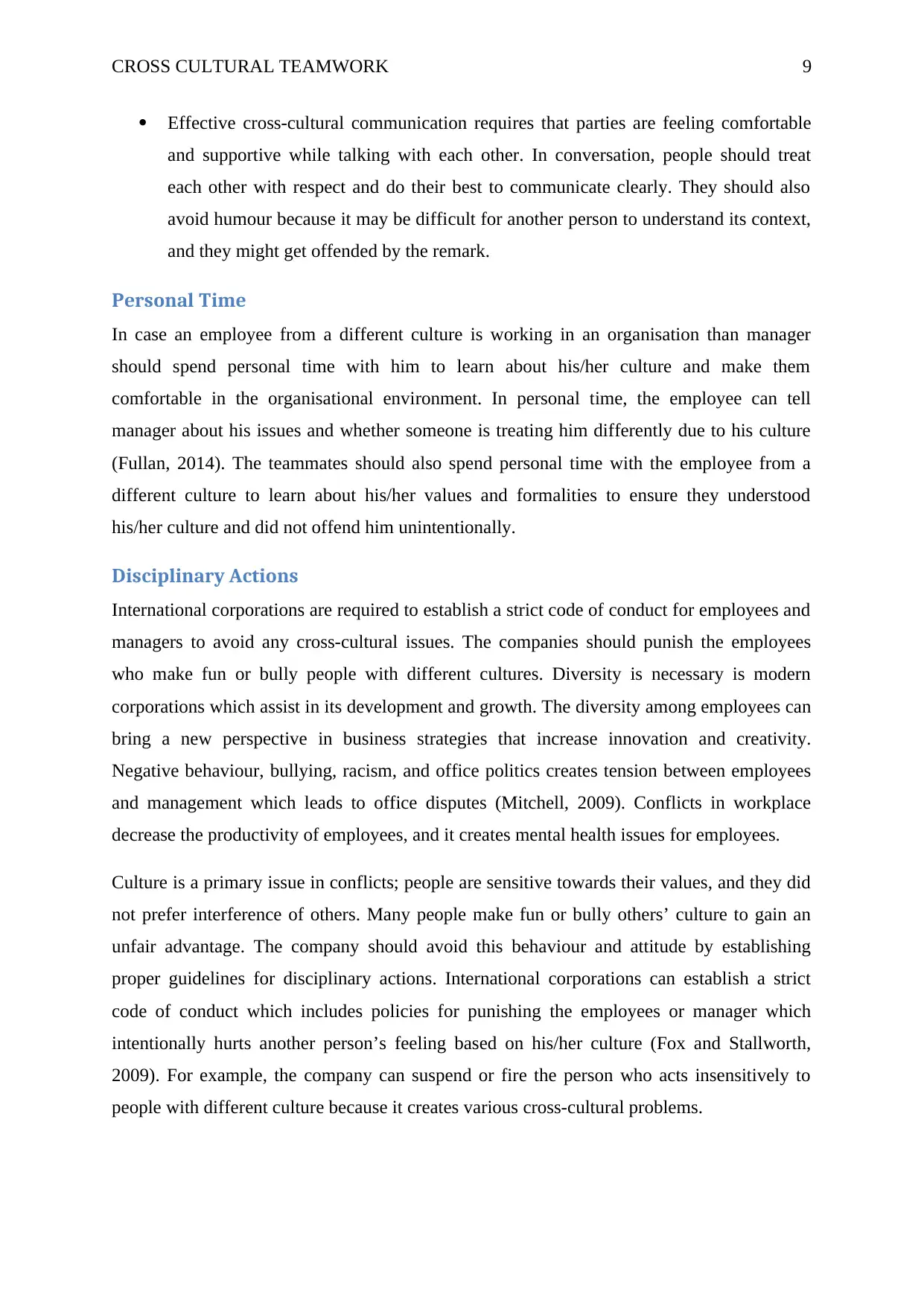
CROSS CULTURAL TEAMWORK 9
Effective cross-cultural communication requires that parties are feeling comfortable
and supportive while talking with each other. In conversation, people should treat
each other with respect and do their best to communicate clearly. They should also
avoid humour because it may be difficult for another person to understand its context,
and they might get offended by the remark.
Personal Time
In case an employee from a different culture is working in an organisation than manager
should spend personal time with him to learn about his/her culture and make them
comfortable in the organisational environment. In personal time, the employee can tell
manager about his issues and whether someone is treating him differently due to his culture
(Fullan, 2014). The teammates should also spend personal time with the employee from a
different culture to learn about his/her values and formalities to ensure they understood
his/her culture and did not offend him unintentionally.
Disciplinary Actions
International corporations are required to establish a strict code of conduct for employees and
managers to avoid any cross-cultural issues. The companies should punish the employees
who make fun or bully people with different cultures. Diversity is necessary is modern
corporations which assist in its development and growth. The diversity among employees can
bring a new perspective in business strategies that increase innovation and creativity.
Negative behaviour, bullying, racism, and office politics creates tension between employees
and management which leads to office disputes (Mitchell, 2009). Conflicts in workplace
decrease the productivity of employees, and it creates mental health issues for employees.
Culture is a primary issue in conflicts; people are sensitive towards their values, and they did
not prefer interference of others. Many people make fun or bully others’ culture to gain an
unfair advantage. The company should avoid this behaviour and attitude by establishing
proper guidelines for disciplinary actions. International corporations can establish a strict
code of conduct which includes policies for punishing the employees or manager which
intentionally hurts another person’s feeling based on his/her culture (Fox and Stallworth,
2009). For example, the company can suspend or fire the person who acts insensitively to
people with different culture because it creates various cross-cultural problems.
Effective cross-cultural communication requires that parties are feeling comfortable
and supportive while talking with each other. In conversation, people should treat
each other with respect and do their best to communicate clearly. They should also
avoid humour because it may be difficult for another person to understand its context,
and they might get offended by the remark.
Personal Time
In case an employee from a different culture is working in an organisation than manager
should spend personal time with him to learn about his/her culture and make them
comfortable in the organisational environment. In personal time, the employee can tell
manager about his issues and whether someone is treating him differently due to his culture
(Fullan, 2014). The teammates should also spend personal time with the employee from a
different culture to learn about his/her values and formalities to ensure they understood
his/her culture and did not offend him unintentionally.
Disciplinary Actions
International corporations are required to establish a strict code of conduct for employees and
managers to avoid any cross-cultural issues. The companies should punish the employees
who make fun or bully people with different cultures. Diversity is necessary is modern
corporations which assist in its development and growth. The diversity among employees can
bring a new perspective in business strategies that increase innovation and creativity.
Negative behaviour, bullying, racism, and office politics creates tension between employees
and management which leads to office disputes (Mitchell, 2009). Conflicts in workplace
decrease the productivity of employees, and it creates mental health issues for employees.
Culture is a primary issue in conflicts; people are sensitive towards their values, and they did
not prefer interference of others. Many people make fun or bully others’ culture to gain an
unfair advantage. The company should avoid this behaviour and attitude by establishing
proper guidelines for disciplinary actions. International corporations can establish a strict
code of conduct which includes policies for punishing the employees or manager which
intentionally hurts another person’s feeling based on his/her culture (Fox and Stallworth,
2009). For example, the company can suspend or fire the person who acts insensitively to
people with different culture because it creates various cross-cultural problems.
Paraphrase This Document
Need a fresh take? Get an instant paraphrase of this document with our AI Paraphraser
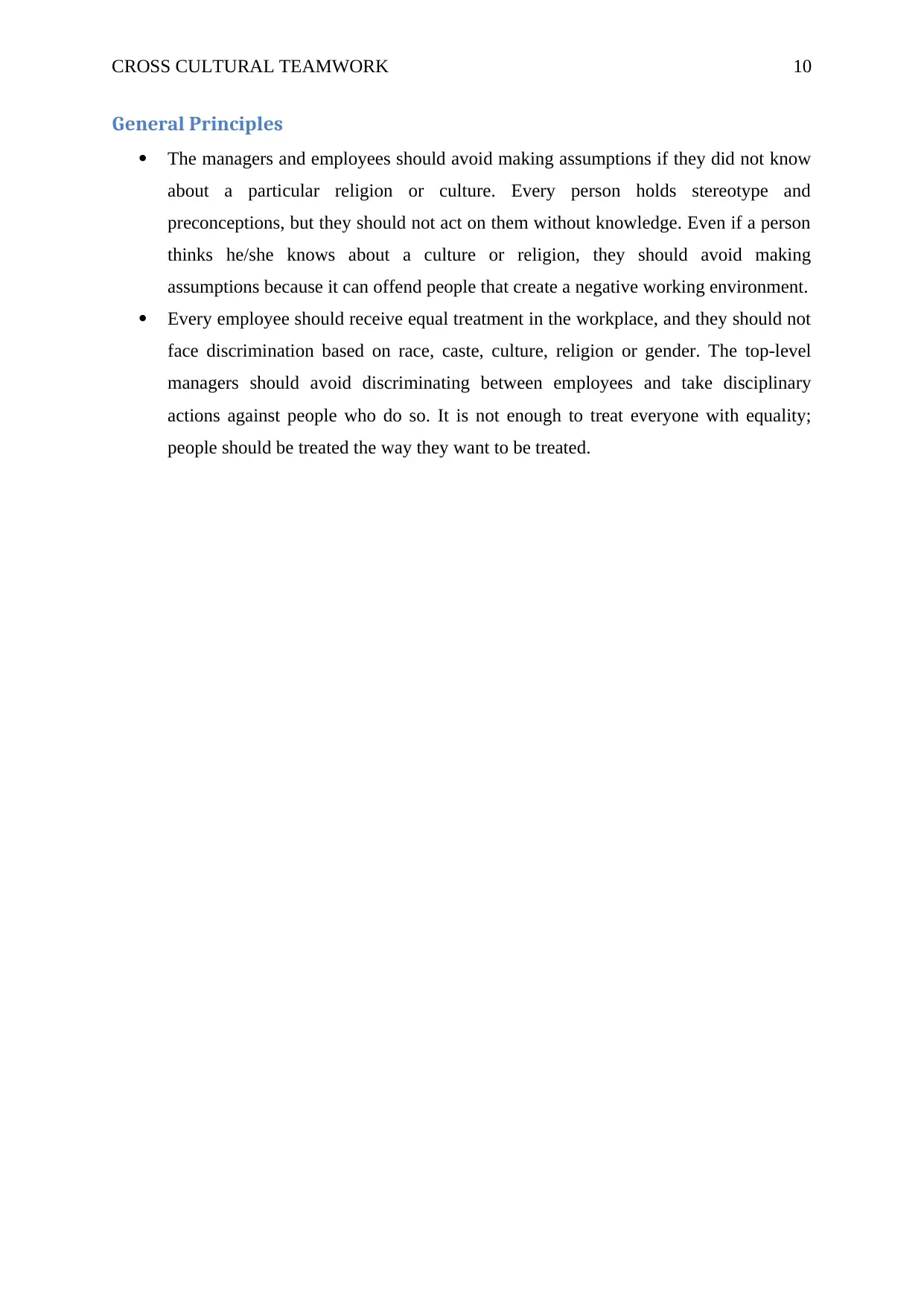
CROSS CULTURAL TEAMWORK 10
General Principles
The managers and employees should avoid making assumptions if they did not know
about a particular religion or culture. Every person holds stereotype and
preconceptions, but they should not act on them without knowledge. Even if a person
thinks he/she knows about a culture or religion, they should avoid making
assumptions because it can offend people that create a negative working environment.
Every employee should receive equal treatment in the workplace, and they should not
face discrimination based on race, caste, culture, religion or gender. The top-level
managers should avoid discriminating between employees and take disciplinary
actions against people who do so. It is not enough to treat everyone with equality;
people should be treated the way they want to be treated.
General Principles
The managers and employees should avoid making assumptions if they did not know
about a particular religion or culture. Every person holds stereotype and
preconceptions, but they should not act on them without knowledge. Even if a person
thinks he/she knows about a culture or religion, they should avoid making
assumptions because it can offend people that create a negative working environment.
Every employee should receive equal treatment in the workplace, and they should not
face discrimination based on race, caste, culture, religion or gender. The top-level
managers should avoid discriminating between employees and take disciplinary
actions against people who do so. It is not enough to treat everyone with equality;
people should be treated the way they want to be treated.
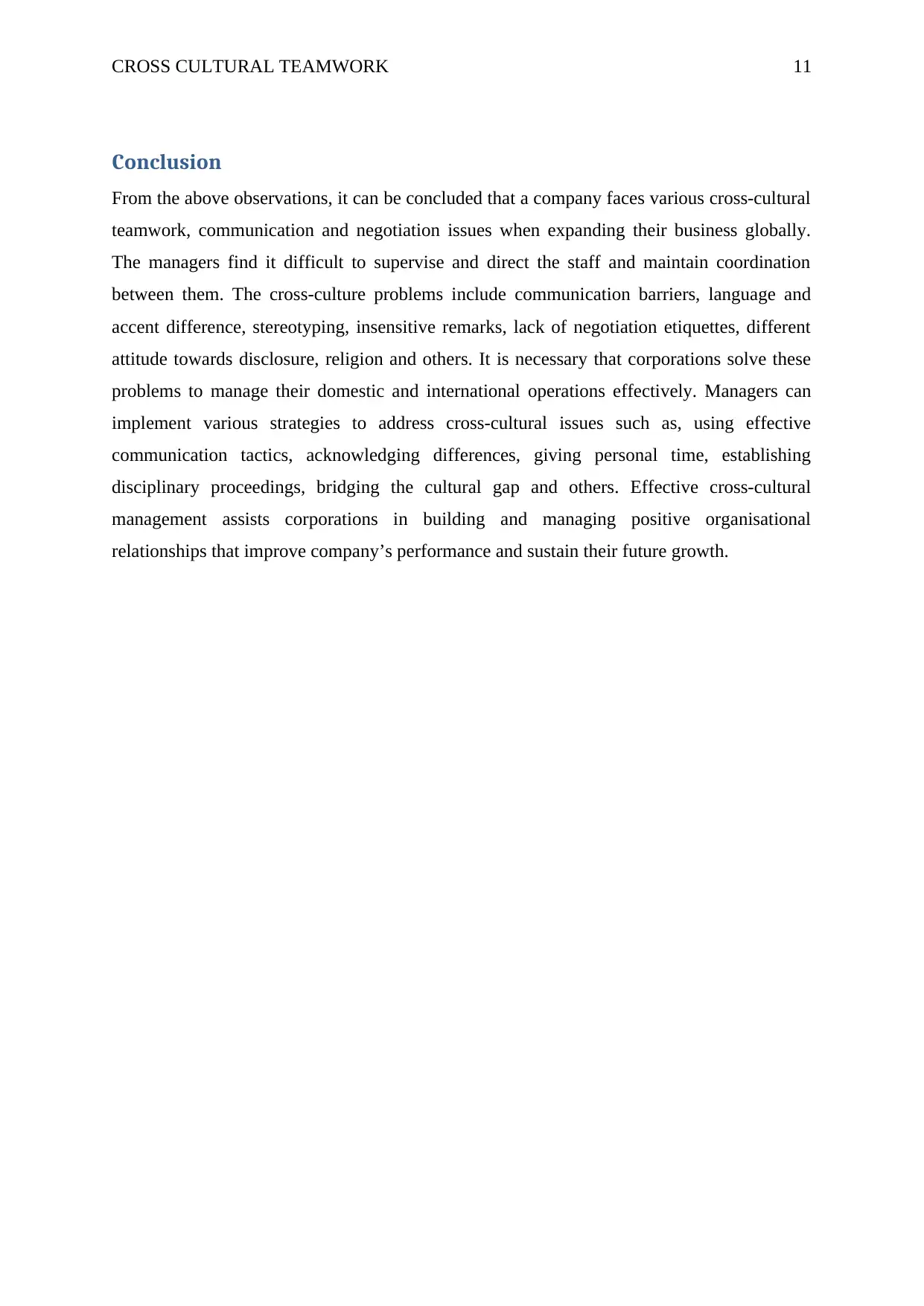
CROSS CULTURAL TEAMWORK 11
Conclusion
From the above observations, it can be concluded that a company faces various cross-cultural
teamwork, communication and negotiation issues when expanding their business globally.
The managers find it difficult to supervise and direct the staff and maintain coordination
between them. The cross-culture problems include communication barriers, language and
accent difference, stereotyping, insensitive remarks, lack of negotiation etiquettes, different
attitude towards disclosure, religion and others. It is necessary that corporations solve these
problems to manage their domestic and international operations effectively. Managers can
implement various strategies to address cross-cultural issues such as, using effective
communication tactics, acknowledging differences, giving personal time, establishing
disciplinary proceedings, bridging the cultural gap and others. Effective cross-cultural
management assists corporations in building and managing positive organisational
relationships that improve company’s performance and sustain their future growth.
Conclusion
From the above observations, it can be concluded that a company faces various cross-cultural
teamwork, communication and negotiation issues when expanding their business globally.
The managers find it difficult to supervise and direct the staff and maintain coordination
between them. The cross-culture problems include communication barriers, language and
accent difference, stereotyping, insensitive remarks, lack of negotiation etiquettes, different
attitude towards disclosure, religion and others. It is necessary that corporations solve these
problems to manage their domestic and international operations effectively. Managers can
implement various strategies to address cross-cultural issues such as, using effective
communication tactics, acknowledging differences, giving personal time, establishing
disciplinary proceedings, bridging the cultural gap and others. Effective cross-cultural
management assists corporations in building and managing positive organisational
relationships that improve company’s performance and sustain their future growth.
⊘ This is a preview!⊘
Do you want full access?
Subscribe today to unlock all pages.

Trusted by 1+ million students worldwide
1 out of 14
Related Documents
Your All-in-One AI-Powered Toolkit for Academic Success.
+13062052269
info@desklib.com
Available 24*7 on WhatsApp / Email
![[object Object]](/_next/static/media/star-bottom.7253800d.svg)
Unlock your academic potential
Copyright © 2020–2025 A2Z Services. All Rights Reserved. Developed and managed by ZUCOL.




